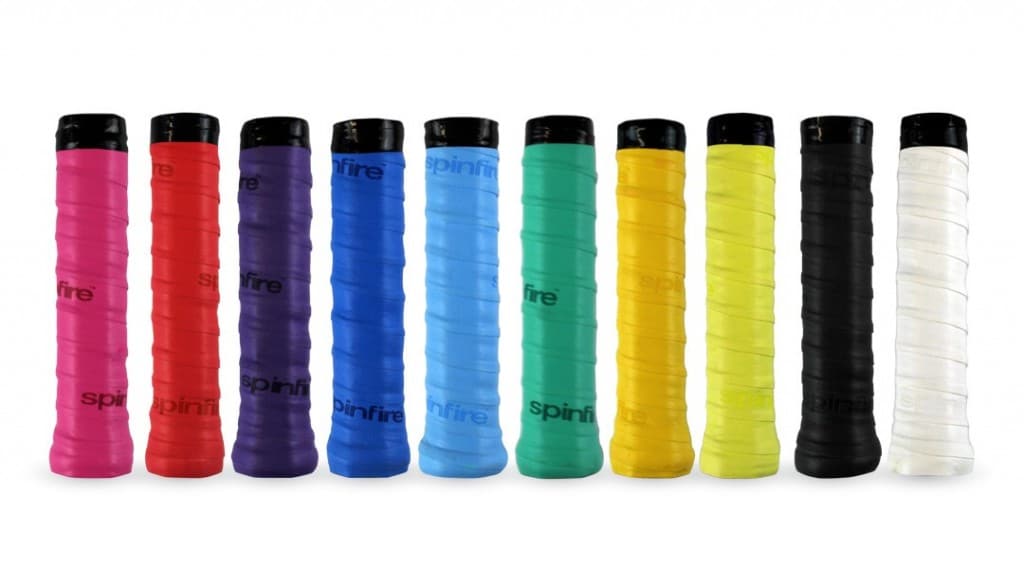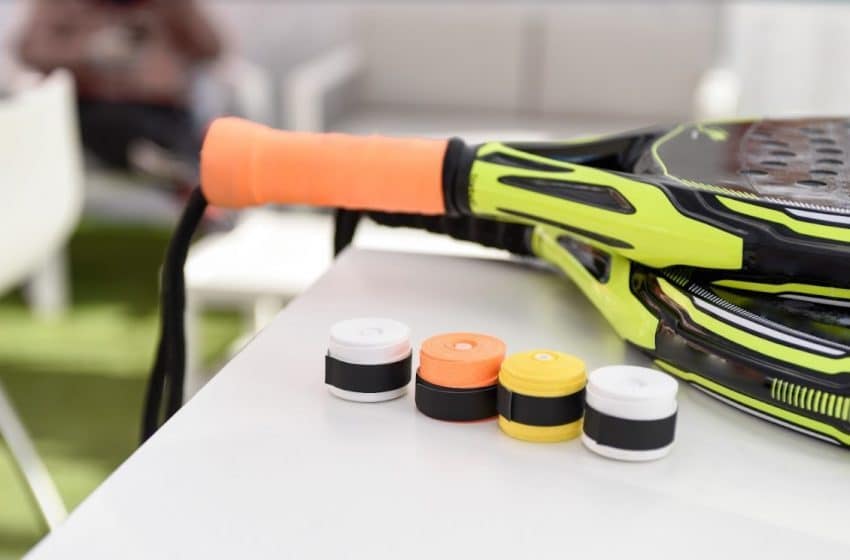One thing that newbie padel players neglect but top players highly value is the overgrip. You can have all the skills needed, but an ineffective and old overgrip will throw you off.
The overgrip, which you wrap around the racket handle, ensures you have extra grip, proper handling, and better sweat absorption.
That said, you must change padel overgrip regularly. But how often is “regular”?
Well, it depends on multiple factors. We’ll elaborate more below.
Grip vs. Overgrip: What is the difference?
Padel rackets already come with an original grip at the bottom, which is what we call the “normal grip.” The overgrip is the thinner that you overlay on top of it.
Many players have varying overgrip preferences. Some are okay with the normal one, but most would require 2-3 layers. The thickness improves the grip and stance depending on the hand size.
What is a padel overgrip?
Most players add this because, unlike a tennis grip, padel rackets only come in one grip size, so the adjustment is crucial to ensure effective shots.
Overgrips make the handle thicker and customized to the player’s comfort. It makes playing easier as you hit more accurately without injuring yourself.
A padel overgrip is a bandage-like material that players wrap around the padel racket handle for better grip. Very similar to those existing in other racket sport such as tennis, badminton, squash etc.
It seems like a simple sticky tape, but it changes the game – literally!
How many overgrips should you use?
It all depends on the player’s personal preference. Some professionals use none, while some use up to five overgrips. On average, players use 2-3.
Again, it’s all about what can improve your shot.
The number of overgrips doesn’t say anything about your skills. You should use the number that makes you feel good and comfortable while playing padel.
Recommendation:
If you don’t have a preference, try following this general rule: there must be a one-finger space between your top finger and palm when wrapped around — but it’s not a padel requirement.

Why you need a grip on your racket
Overgrip is crucial in playing padel, as we keep mentioning. But how exactly does this piece of bandage tape improve your game?
1. Increases comfort while playing padel
Since there are no one-size-fits-all racquet handle options, players can’t exactly choose upon purchase. The adjustments are made possible by overgrips, which is a trial-and-error matter.
People with larger grips will find it difficult to hold a small racket for long periods. The same goes when you hold on to it too tightly.
And as we know, a strained hand is always bad news in sports like padel and tennis!
Adding an overgrip will make the racket handle thicker and easier on the palm, thus increasing the player’s efficiency.
The better the comfort, the better the striking performance and accuracy.
2. Allows padel player to maintain control
Padel and tennis players like you know that controlling your wrists and arms is vital on the court. Well, much of this comes from the palm grip.
Your grip should properly absorb the tension of the ball, leading to better control during the match.
Having a good grip also make you hit more accurately and quickly since you’re not struggling to move your racket around. It can greatly help you find the sweet spot thereby maximizing your accuracy.
3. Helps absorb sweat on the padel racquet handle
For people with sweaty palms, great news! Overgrips absorb sweat and moisture excellently, so there’s no room for a slippery handle here.
Sweat is inevitable when you play padel, so having a handle that absorbs all the sweat is a massive help while hitting the ball.
There’s a bit of variety with padel overgrip materials. The primary grip options are (1) tacky and (2) dry:
- Tacky padel grips are stickier than usual and are non-absorbent. It’s for padel players who don’t have sweaty hands and would like to stick their palms better to the handle’s surface. It helps the padel racket stay put as they make better shots on the court. Wilson Pro is a brand example that carries tacky padel overgrips.
- Dry padel grips are more absorbent. It’s not as durable as tacky grips, and the moisture might require more frequent changing, but it’s perfect for sweaty palms. Tourna Grip has many racket grip options that are dry and absorbent, preventing rackets from sliding off your hand as you hit the ball.
4. Prevents padel injuries
You’re more prone to shoulder and arm injuries without a proper padel racket grip. One wrong move can cause a sprain or worsen an existing condition.
One common condition is the tennis elbow. It results from strenuous arm activity, and your tendons are overworked. Padel and tennis players know how painful it is!
And while injured players are not encouraged to play, some who have no choice adjust the padel overgrip to aid them in court during the match.
5. Increases padel performance and hitting effectiveness
Overall, having a padel racket that suits your grip and comfort level will improve your performance.
It’s not a magic adhesive – you don’t become a padel or tennis professional by simply adding an overgrip, but it helps you play and serve the ball better.
Getting the best grips that match your padel racket and hand comfort is highly recommended. Only then can you play with ease without hurting yourself.
When should I change my padel overgrip?
There’s no universal rule when it comes to getting a new overgrip. You replace them as needed, and that “need” varies from one player to another.
But as a general rule of thumb, you should get a padel replacement grip at least once a month and even more when you have a match or play often.
During tournaments, players even switch up the replacement grip every round to ensure a fresh padel racquet every time they play.
Overgrips are inexpensive and often come in bulk, so frequent changes are not a problem, especially if they change your play performance (and even your athlete’s life!).
It would be best if you got a padel replacement grip when:
- Your padel grip is worn out and dirty
- You have sweaty hands, and your padel overgrip is wet
- It feels different while playing
- It’s time change (set a regular schedule: once a month or once every two weeks)
Recommended reading:
How to change your padel racket overgrip (tutorial)
What is the Best Grip for a Padel racket (buyer’s guide and our top picks)
Enhance your grip with 4on totalgrip spray
X-Grip vs. Hesacore, which is better?
How to make your padel overgrip last longer
The most straightforward answer is not to play, which isn’t the answer we’re looking for. Changing padel racket overgrips (as it is with a tennis overgrip) is unavoidable.
Some factors, like sweat, are beyond your control. You also can’t help but play hard during games. The material is bound to get worn out, one way or another.
Perhaps you can purchase the more expensive and high-quality brands to make them last a little longer. But in the end, replacing the grip is a must.
How to change a padel racket overgrip
It’s easy to change the grip but often unfamiliar to most.
Here’s a basic step-by-step:
- Remove the plastic on the sticky side (but don’t throw it away).
- Start wrapping the grip using the thin end with the adhesive at the bottom part of the padel racket.
- Use your thumb finger to hold it as you work your way up the padel racket handle.
- If you like a thick bottom, wrap more of the roll before working your way up.
- Wrap according to your desired thickness. If you want a thin grip, the first layer should be enough. If you want a thick grip, overlap as many as you like.
- When you reach the end of the racket handle, grab the end and pull it off (or cut it with scissors, if available). The hand orientation doesn’t matter here. Lefties, pull with your left hand. Righties, use the right.
- Using the plastic adhesive, wrap it around the end to secure it.
In Summary
There’s no one rule on how often you should change the replacement grip, so it’s entirely up to your preference, schedule, and product quality.
Padel overgrips may not look like much, but they significantly improve the players’ performances. And for such an inexpensive item, changing it regularly is worth the effort.
Frequently Asked Questions – What is a Padel Overgrip and when should I change it?
The grip is the existing one on your padel racket handle. An overgrip is the additional bandage you wrap around to increase the size and improve hand grip.
It would help if you replaced your padel overgrip whenever needed and as situations vary. Some instances include but are not limited to worn out, dirty, and sweaty overgrips.
You should change it regularly, possibly once a month or even more. If you want a fresh one every game, you can also do so accordingly.
Purchase high-quality brands with materials that don’t get easily worn out. Use absorbent overgrips to avoid excessive moisture for unavoidable situations like sweaty palms.

Lucas Sánchez is the founder of SimplePadel. Born and raised in Spain, Lucas has been living in the US and UK for the last 20 years and currently calls Miami his home. While he’s never played professionally, the dream is still alive.
Lucas loves nothing more than playing (and talking) about padel, and he considers himself lucky to have a wife and family that share his love for the game.

10 replies on “What is a padel overgrip, and when should I change grip?”
[…] fiber bats offer more power, resistance, and durability. It’s designed for the player to have a good grip plus a nice spin on the ball upon […]
[…] What is a Padel overgrip and when should I change it? […]
[…] you are an amateur or professional, using a grip is an added help for a better game. The most known ones are X-Grip and Hesacore grip. The question […]
[…] into your hand. Overgrips are more common to change, so it’s important that you understand what a padel overgrip is and when you should change it, and how it can help your […]
[…] it throws you off, it’s worth replacing the grip to avoid affecting your shots during the game. After all, these are inexpensive, and frequent […]
[…] open face plus continental grip is VITAL in providing enough height and force to clear the net and strike the ball towards the […]
[…] the grip has become uncomfortable, this is a sign that it needs replacing. You can obviously also replace the grip, but also see the next paragraph.Furthermore, if the grip is no longer holding the padel racket […]
[…] your elbow hurts while playing Padel, your racket’s grip may be too small. Consider adding an overgrip to your racket for […]
[…] Rackets can be made more comfortable by adding an over grip or under grip, which will enhance your padel […]
[…] https://simplepadel.com/what-is-a-padel-overgrip-when-change-grip/ […]